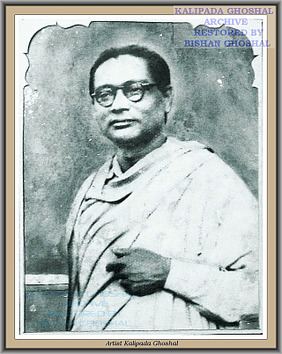Nationality Indian Role Artist Name Kalipada Ghoshal | Movement Modern Indian Art Known for Painting | |
 | ||
Kalipada Ghoshal | Biography | Art style | Paintings | Achievements
Kalipada Ghoshal (Bengali: কালিপদ ঘোষাল) Kali-Pado meaning who is under Mother Goddess Kali. He was an artist from Calcutta. He was the last successor of Abanindranath Tagore's Indian Society of Oriental Art and Bengal school of art.
Contents
- Kalipada Ghoshal Biography Art style Paintings Achievements
- Early life
- Career
- Honours and awards
- List of paintings
- References

Early life
Kalipada Ghoshal was born in September 1906 in an economically modest family in a tiny village named Jadabbati situated between two villages named Munsirhat and Maju under Jagatballavpur P.S.Howrah Bengal British India. He was the eldest son of his father Gyanodacharan and mother Bashantakumari. His curiosity & interest towards arts was developed at his early childhood. At the age of 10 he often went to his maternal home in Gobindapur which is another small village situated within few kilometres from his home. Later he named this place as the village of art (shilpogram), where he used to visit local clay model makers of Hindu Gods & Goddesses. He started helping the local mural artists by painting Chalchitra . Soon he became popular among the villagers for his extraordinary brush strokes, which helped him to introduce with young Nandalal Bose through Bose's brother-in-law named Kalipada Bose.
In the year 1920 Kalipada went to Jorasanko thakurbari (the residence of Rabindranath Tagore) with Nandalal Bose where he met the art teacher Abanindranath Tagore. Tagore was pleased with his art but suggested him to go back and concentrate in his school studies. But Ghoshal ran away from his village and went to Tagore to learn.
For the first few years Abanindranath groomed Kalipada personally at his residence. Kalipada had spent few valuable years at jorasanko, where he observed & got the valuable opportunities to interact with many great personalities of Jorasanko including Rabindranath Tagore at his time. Later he became the drawing teacher of the juveniles of the Tagore family (Jorasanko Thakur bari) including Tagore's own sister Sabita Tagore. Beside painting Kalipada had a keen passion in music. He had learned Indian traditional Classical Music & Musical instruments including Esraj and Clarinet.
Career
In 1922 Abanindranath Tagore admitted Kalipada in his own School ho – Indian Society of Oriental Art. Here Kalipada was trained by Sailen Dey, Kartick Banerjee, Khitindranath Majumder, sculptor Giridhari Mahapatro of Orissa beside Abanindranath Tagore. Kalipada was also trained under some famous Japanese Artists like Yokoyama Taikan. He learned Chinese & Japanese techniques beside traditional Indian & European styles. During his student life, Kalipada also participated at the Society's art exhibitions for several times & earned special reputation for his work. Gaganendranath Tagore himself bought Kalipada's painting from the Society's exhibition. During this period he started living in a rental mess house when his Guru Abanindranath Tagore had arranged a scholarship of Rupees 20 per month for his art education & living. He stood first and was honoured with a Gold medal and completed his art training course successfully from Gaganendranath & Abanindranath Tagore's Indian Society of Oriental Art in 1928. In the same year Kalipada was appointed as an art teacher in the Indian Society of Oriental Art.
Ghoshal got the Royal invitation from the British Government for the fresco work for the newly constructed London India House UK. He was the only artist whose large sized 10x6 feet Wash Tempera painting of Shri Chaitanya – a Hindu deity (Title: Shri Chaytanyer Abhishar / Chaitanya at dancing posture) and some fresco samples were selected by the selection committee for decorating the wall of London India House. Abanindranath Tagore insisted & encouraged him for travelling abroad, and strictly ordered him not to miss the rare opportunity. Beside his teachers some of his colleagues like Mukul Dey was also preparing him for his trip to England. His trip had been delayed because of the sudden & unexpected death of his father. His mother died a year before his father's death. Therefore, Kalipada had to cancel his trip to England, and lost the opportunity of London India House's Fresco work permanently. He had to stay with his orphan brothers as their only guardian & continued his teaching work at the Indian Society of Oriental Art, Calcutta.
In 1928, All India National Congress Conference was held at Calcutta. Before the conference the presentation committee requested Abanindranath Tagore to take the charge of the decoration work within a week. Kalipada Ghoshal created a large painting (Title: Jal sawa) on a traditional social custom of Bengali marriage ceremony as the symbol of auspiciousness, bonding & success for the decoration of the main entrance gate of the All India National Congress Conference arena.
A special article on the successful artists from the Oriental Society of Arts including Nandalal Bose, Abanindranath Tagore & Kalipada Ghoshal's masterpieces were published with the 3 pictures of the paintings with the critical comments & thorough discussions on their styles, techniques & presentations in Jugantar on 19 September 1937. The published paintings were, Shiber bish paan (later renamed as shiber halahal pan) by Nandalal Bose, Trishwa Rakshita (Later renamed as Akhoka's Queen) by Abanindranath Tagore, and Shri Chaitanyaer Abhishar by Kalipada Ghoshal.
